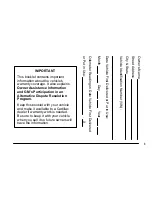
Catalog #17932
Brochure #63-0222
Page 2 of 4
©2003 Edelbrock Corporation
Rev. 11/03
(Note: This rotary fuel injection pump will not work
on carbureted fuel systems. It is for electronic fuel
injection only.)
(Note: The word “bracket” used throughout these
instructions refers to the fuel pump mounting
bracket and fuel level sender assembly.)
PREPARATION
1. Make sure the engine is cool and the vehicle is on level
ground. Set the parking brake.
2. Remove the negative (ground) cable from the battery
and position it so that it cannot make a connection to
the battery during the fuel pump installation
procedure.
3. Relieve fuel system pressure by using a pressure
gauge tool, Ford Service tool # T80L-9974-B or
equivalent. Connect the pressure gauge to the
Schrader valve located on the engine fuel rail. Slowly
open the pressure gauge valve and drain the fuel into
a suitable container to relieve the fuel system
pressure.
(This procedure is necessary since the fuel
system can retain gasoline under pressure for a
considerable period of time. Opening a pressurized
line could spray fuel, creating a risk of fire or personal
injury.)
4. Drain the fuel tank. Use an OSHA-approved gasoline
transfer pump, and remove as much fuel as possible
through the fuel tank filler neck. Store the fuel in
approved safety containers only.
5. Lift and safely support the vehicle with approved
safety stands with enough height to gain clearance to
remove the fuel tank. If lifting only the rear of the
vehicle, remember to block the front wheels.
6. Once the vehicle is lifted and supported, an alternate
method of fuel removal may be implemented.
Determine which line is the fuel return line going back
to the fuel tank
(See Fig. 1)
. Trace the return line
back from the injectors and remove it from the
bracket. Securely attach a hose to the exposed fuel
return tube leading into the tank, and draw the
remaining fuel out and into an approved container.
(Note: Regardless of the method used to remove
fuel from the tank, it is important to remove as much
fuel as possible before removing the tank. This is
required to help prevent fuel spillage, and injury
from excessive weight while removing the tank).
INSTALLATION PROCEDURE
FUEL TANK REMOVAL
(Caution: The fuel tank can be quite awkward to
remove due to its size and weight. Obtain help during
its removal).
(Note: The following instructions may not be specific
to your particular vehicle. See your factory service
manual for specific instructions).
1. Prior to removing the retaining clips in the fuel line
connectors, note their styles and respective fuel line
location. The 1/4” fuel line connector uses a duckbill
style retainer, and the 5/16” fuel line connector uses a
hairpin style clip. The specific service manual for this
vehicle has a section on fuel lines, fuel line connectors,
and fuel line connector retainers that may be referred to,
if necessary, for help in removing the clips and/or fuel
lines. Remove the retaining clips from the fuel line
connectors and remove the fuel lines from the pump
bracket. Check for and remove any other hoses that may
be attached to the fuel tank.
2. Disconnect the electrical connector at the fuel tank to
main harness connector. Support and partially lower the
tank, if needed.
3. Remove the fuel filler neck, if necessary.
4. Support the fuel tank and remove the retaining straps to
allow the tank to be removed from the vehicle. Remove
the fuel tank being careful not to spill any remaining fuel.
5. Note the condition and position of all fuel tank mounting
pads and insulators used to isolate the fuel tank from the
vehicle body. Mislocated, deteriorated, or incorrect pads
and/or insulators can cause objectionable transmission of
fuel pump noise into the vehicle.
Fig. 1
Fuel Tank
Fuel Pressure Regulator
Fuel Return Line
Injector(s)
Fuel Filter
Vapor Canister
Typical Fuel System






















